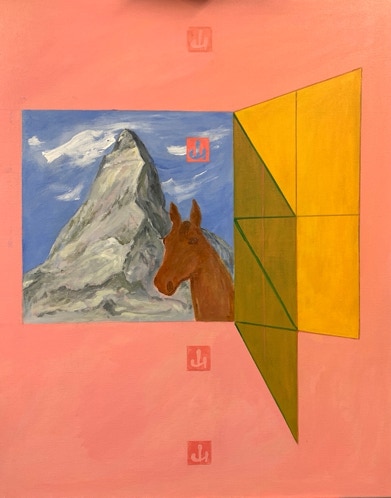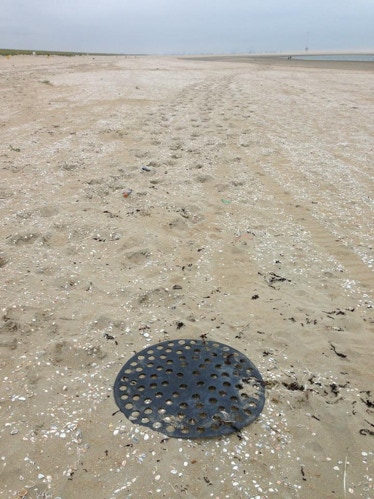
Inhoudsopgave Episode 2:
Simulacrum 2
Hilarius Hofstede
Early Works
Aardig Onderweg
hannah perner-wilson
Otaku 2
Ted Joans
Past in the present 2
Headquarters
Travel Diary excerpt
Swatch Exchange Rituals
Ido van Blijdesteijn, Recht In De Ogen
Evelien de Jong
Textile publication 2
Fashion Tech Farm
Barbara Helmer, Zonder Titel, 1992,
olieverf en lakverf op doek, 150 x 170 cm
Barbara Helmer, Zonder Titel (Legoplaat afdrukken), 1982,
gouache op papier, A4 en 65,5 x 36,5 cm


Editor Woody van Amen
Aardig onderweg
Contribution by hannah perner-wilson
Editor Contrechoc
Bezoekers aan het exquise restaurant. Tekening Otaku.
Otaku bezoekt geen tentoonstelling
Otaku maakt zelf. Kijken naar wat anderen gemaakt
hebben kost tijd die Otaku niet zelf kan besteden
aan maken. Tentoonstelling bezoeken is dus
consumeren. Consumeren doet Otaku als Otaku
geen zin heeft om iets te doen. Dat is nooit het
geval. Er kan intellectueel over
tentoonstellingsbezoek gedaan worden, noem het
de competentie omgevingsgerichtheid. Dat is
volkomen onzin. Alleen het maken zelf vertelt de
maker over het maken. Niet wat anderen al
gemaakt hebben. Wat anderen maakten is af.
Maken is een proces, een doen. De influisteringen
van het maaksel tijdens het maken kunnen niet
door consumptie van wat af is worden doorgrond.
Otaku 2 – met tekeningen van Otaku
Otaku disclaimer
Otaku bestaat niet. Otaku is fictie. Otaku is woord.
Als iets van Otaku lijkt op de werkelijkheid is dat
puur toeval.
Otaku maakt zelf. Tekening van Otaku.
Bezoekers van het museum in karakteristieke pose, getekend door Otaku.
Otaku begrijpt dat allemaal niet.
Een tentoonstelling is bovendien als tentoonstelling ontworpen. Dat wil zeggen ingericht om indruk te
maken als tentoonstelling. Het ego van de
conservator is datgene wat wordt tentoongesteld. Maar het ego van de curator is ook bijzaak. Het
museum gebouw is ontworpen voor het ego van
een sterarchitect. Maar het ego van deze godheid
architect is ook bijzaak. Alle design en kunst is
bijzaak maar net nodig om het gebouw "museum"
te laten zijn - wat ook bijzaak is. Alleen het
restaurant van het museum is de hoofdzaak. De
doelgroep is niet de kunstliefhebber maar de
espresso toerist. Toeristen willen namelijk drinken
en eten en vooral naar het toilet. Toeristen
consumeren voordat zij een sanitaire stop
uitvoeren en vormen een deel van de economie
van een stad. Industrie ook, maar die drinkt geen
cappuccino. Het doel van de stad is winst maken,
het is een onderneming, het land moet ervan
leven.
Otaku werkt in het atelier.
(wordt vervolgd)

Trade-Plough Headquarters in Rotterdam.

Finger Eating Plant spotted in Schiebroek.
Editor: Beam Contrechoc
Travel diary excerpt, 27 August 2018
“Wyke”
Big blocks of bricks of houses long gone
“Baviaan”
- ‘We are now 4,5 hours late.’
- ‘Why?’
- ‘Signals.’
Matjiesfontein, nursery & herb garden
Bushbuck
“Konstabel”
Passing a freight train, standing still
Running horses in the veld, rainbow over
mountains in the distance (dark clouds but
light)
Touwsrivier. Bright orange flowers along the
tracks and in the veld. The station building is a
ruin without roof. The only sign intact says ‘No
hawkers’.
Editor Leonor Faber-Jonker
This “e-textile swatch book exchange” has been
repeated 7 times now, resulting in 6 books full of e-
textiles samples, and one cover without any
samples. The documentation is
Editor Beam Contrechoc
Swatch Exchange Rituals
As from the summer of 2013 e-textile
designers came together in the small
village of Poncé sur le Loir in the middle ofFrance
in “Les Moulins de Paillard”.
http://etextile-summercamp.org/2014/
After Episode one of this series, we are now inside
the e-textile summercamp.
E-textile designer-artistscame from all over the
world, Scotland, the USA, Taiwan, India, Italy, Spain,
Japan, Germany, the Netherlands, Belgium,
Hungary, France and other countries.They came
from home, school, universities or companies.
These designers all occupy themselves with the
hybrid field of textiles, new materials and
interactivity. They are makers, they experiment,
they try out. In those days they were very few, for
example, there was only one single e-textile
designer living in the whole of Taiwan and he came
to the summercamp in France! Compare that with
the number of artists living everywhere… in
Rotterdam alone, around 2000. We were so happy
to meet other persons talking in this e-textile
language!!!
One of the highly specialized activities during the sunmmercamp was the so called “Swatch Book
Exchange”.
Hannah Perner-Wilson from Berlin came up with
the idea of an “exchange” between the
participating designers of physical e-textiles in the
form of a “book”.
online: http://etextile-summercamp.org/swatch-exchange/.
How does this exchange work?
Practically, the participants had to bring 25 copies
of one of their experiments.
So first a call for ideas. Select one of the many ideas
you have lying around. Criticize. Then an
experiment. Criticize again. Then a first
documentation. Submit your idea. Then the stress
that your experiment might not be selected by the
angry e-textile swatch exchange critics.
Imagine one of the “swatches” is like this:
Exobag - e-textile swatch 2013 – with
microcontroller and light sensor.
Having an idea and a working swatch is not enough.
You have to make 25. Production!
Making 25 or so copies always turned out to be
harder then imagined. Some kind of a production
line or system had to be set up, ordering materials
and components, some strategy to multiply the
experiment, the electronics, the textiles and in the
end testing the 25 swatch copies for the swatch
book.
Transport the copies by car, plane, train to this
remote spot in France…
There was a hard deadline: the beginning of the summercamp. No excuses for being late!
Testing 25 copies of the exobag.
During the week together in France these pages
brought by every participant were collected and
distributed so that every participant received a
copy of the page of every other participant.
The making of the swatch exchange book - gathering the pages. (Picture Hannah Perner- Wilson)
The way this swatch ended up in the 2013 Swatch
book.
After making the actual book we had to sit down
together and present the swatches. Explain the
idea to the others. Show that it really works.
The gathering of the participants of the Swatch
Exchange Ritual: Explanations (picture Tincuta Heinzel)
The whole process was a strange sensation.
Enormous amounts of work. But then “a real piece
of work’. A totally different experience compared
to the “online” version.
Online, you can perform tricks, hide the corners,
“as if”…no way for the real thing to hide anything!
In 2017, all the swatches up til then were shown
side by side...so many!
Questions:
Why did everybody do all this work, spending
weeks on the swatches?
Was everybody satisfied with the “exchange”, in
other words was the effort of making the swatches
returned by the other swatches?
Who is the owner of a swatchbook, containing the
work of others?
Is this swatchbook for sale?
What is the relation with some ideas of Baudrillard
on “the gift exchange” in relation to the internal
structures of a community?
Are the ideas of Marcel Mauss on “The gift”
applicable to the Swatch exchange?
The fact that these questions can even be asked,
means that mysterious deep hidden layers are
surfacing…
To be continued….
Recht In De Ogen
Contribution by Ido van Blijdesteijn
to be continued…
Contribution by Evelien de Jong
Episode 2: textile publication
The folding Cube
Editor Beam Contrechoc
These contributions are following an artistic-designer exploration, investigation in publication on textiles "in real time" as far as possible. The next step after some experiments on flat textiles was using "a cube". But where did that cube come from? And what is a textile cube?
From where the cube? This is an years long history, starting in a summer camp like this:
I discovered then, that this fabric cube could be folded over the diagonals, and as the upper side is turned the cube flips flat.
This idea “folding cube” was used in the 2020 e-textile swatch exchange for a textile switch:
Interactive cube garment of course inspired by the famous Pattern Magic of Tomoko Nakamichi - I like that last name which means "in the middel of the road", because I am always "on the road", never reaching anything, not even wanting to...
This idea “folding cube” was used in the 2020 e-textile swatch exchange for a textile switch:
It was like the invasion of the textile cubes in my room…
One of the variations was a cube upon a cube, both with the same rotating folding.
Mother and daughter, Father and son, Cube on Cube
And for the experiment with textiles and publication not the simple cube, but this
cube family was used. Looking back – I should have started with the simple cube,
as can be found out in Episode 3….
To be continued....

Editor Marina Toeters
51.438470688796706,
5.443782327506125
Fashion Tech Farm is een werkplaats,
bedrijfsverzamelgebouw en kleinschalige productie
faciliteit voor innovatieve kleding, In Eindhoven.
Over de Fashion Tech Farm:
De huidige tijd vraagt om nieuwe ontwikkeling in
textiel, interactiviteit, productiemethoden,
verbeelding en business modellen.
In de Fashion Tech Farm wordt hieraan gewerkt door
ontwerpers, ondernemers, wetenschappers en
kunstenaars.
Er zijn vinden kleine kleding producties,
experimenten en samenwerking tussen gebieden
die ooit ver uit elkaar lagen plaats.
Alles wat er aangepakt wordt in de Fashion Tech
Farm is altijd met veel energie, de nodige humor en
maak-plezier!
Citaten:
6: Hoe komt het fashion model over die stalen brug
met haar magnetic socks?
7: Op dit very moment hebben mijn smart umbrella
en intelligent clutch een petit relatieprobleem.
8: Heb jij nog een fashionable mutual NDA te sharen?
9: Ik heb laatst een stuk of 10 shirts met Siri in het
milieupark gedumped: het onderlinge gechat was
niet meer chill.
10: Mijn op afstand bedienbare brassier reageert
niet: het geeft aan zich op dit moment liever te
verdiepen in de teksten van Baudrillard, met name
"La mode ou la féerie du code", uit Traverses /3,
1976, dat alleen nog antiquarisch te verkrijgen is.
The well known problem of the non interactivity of
men.
E-textile experiment.
Mission Statement Bilihome
Bilihome is a start-up supporting young families
during the beginning of new life, while having
jaundice therapy. Besides the development of this
wearable Margret wants to create access to care in
Asia and Africa. For this Margret uses especially
fashion tech which makes it more miniaturized and
easier to handle. It will transfer care from the
hospital to the home. This means cost reduction and
it makes the treatment of babies affordable
About designers working in the Fashion tech Farm:
Margret Huenerbein.
Margret Huenerbein is working in the Fashion Tech
Farm. She manages Bilihome.
Bilihome aims to support jaundiced newborns and
their parents, naturally. The wearable solution allows
optimal blue light therapy and helps babies
to recover in the right environment. By making the
next steps towards a phototherapy wearable,
Bilihome received the concept Red Dot: Best of the































